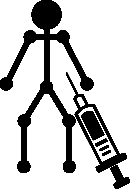Botox (botulinum toxin) has gained interest as a therapeutic option for keloid scars due to its ability to modulate tissue tension, reduce inflammation, and potentially suppress fibroblast activity. Here’s an overview of its use and comparison with intralesional steroid injections and 5-fluorouracil (5-FU):
- Mechanism of Botox in Keloid Treatment
- Botox works by inhibiting the release of acetylcholine, which relaxes the muscles and decreases tension at the wound edges, reducing the risk of abnormal collagen deposition.
- Additionally, it suppresses inflammation and fibroblast activity, factors that contribute to keloid formation and growth.
- Comparative Effectiveness
Botox
- Efficacy: Studies suggest that Botox reduces keloid size, erythema, and pruritus, though evidence remains limited compared to other treatments.
- Safety: Minimal systemic side effects. Local side effects like temporary muscle weakness are rare.
- Limitations: High cost and limited availability.
Intralesional Steroid Injections
- Efficacy: Considered the first-line therapy for keloids, intralesional steroids, such as triamcinolone acetonide, effectively reduce scar size and symptoms (e.g., itching and pain) by inhibiting collagen synthesis and inflammation.
- Safety: Potential side effects include skin atrophy, hypopigmentation, and telangiectasia.
- Limitations: High recurrence rate upon discontinuation.
Intralesional 5-Fluorouracil
- Efficacy: 5-FU is a chemotherapeutic agent that inhibits fibroblast proliferation and extracellular matrix production, offering significant improvement in scar texture and size. It is often combined with steroids for synergistic effects.
- Safety: Side effects include pain at the injection site, hyperpigmentation, or local necrosis.
- Limitations: Requires multiple injections, and long-term data are limited.
- Comparison of Effectiveness
A 2023 review suggests that while Botox shows promise as an adjunct or alternative therapy for keloids, it may not outperform the well-established efficacy of intralesional steroids or 5-FU in terms of scar reduction. However, its superior safety profile and ability to modulate biomechanical tension may make it a valuable part of combination treatments.
Current Consensus
- First-line Therapy: Intralesional steroids.
- Adjuncts: 5-FU, Botox, and laser therapies enhance outcomes, particularly for resistant or recurrent keloids.
- Combination Treatments: Studies favor combining Botox with steroids or 5-FU to exploit different mechanisms of action.
It sounds like Rejuvence Clinic offers a comprehensive approach to keloid scar treatment, combining innovative techniques with individualized care to provide patients with effective solutions. Below is a polished version of the information for clarity and readability:
Keloid Scar Treatments at Rejuvence Clinic
At Rejuvence Clinic, we specialize in treating keloid scars using both surgical and non-surgical methods. Our tailored approach often combines multiple treatment modalities to achieve the best cosmetic results and minimize the risk of recurrence. However, we understand that keloid treatment can be challenging and frustrating for both patients and doctors, even with the most advanced techniques.
Treatment Options
We offer a wide range of options to treat keloid scars, including:
- Intralesional Steroid Injections
These help reduce inflammation, flatten the keloid, and soften the scar tissue.
- Intralesional 5-Fluorouracil (5-FU) Injections
A chemotherapeutic agent used to inhibit excessive scar tissue growth.
- Laser Treatments
- Non-Ablative YAG Laser: Reduces redness and promotes collagen remodeling.
- Ablative Erbium YAG Laser: Improves texture and appearance of the scar.
- Surgical Excision
In combination with other treatments, surgical removal minimizes recurrence risk.
- Cryotherapy
Effective for smaller keloids, cryotherapy freezes the scar tissue, causing it to shrink.
- Intralesional Botox Injections (Experimental)
Botox may reduce tension across the scar and its surrounding tissue, potentially lowering the recurrence risk in cases involving surgical excision of larger keloids. While promising, its use in keloid treatment remains experimental and is assessed on a case-by-case basis.
Why Choose Rejuvence Clinic?
Our clinic takes a holistic approach, considering all available treatments to create an efficient and cost-effective plan tailored to your needs. We aim to deliver value for money while striving for the best outcomes.
Speak to one of our expert doctors, such as Dr. Ghani or Dr. Mitha, to discuss the most suitable options for your keloid treatment.
Contact Us Today
📞 Call us at 0207-531-6600
💬 Message us via the WhatsApp icon on our website.
Reference:
- Hameedi, S.G., Saulsbery, A., Olutoye, O.O. (2024). The Pathophysiology and Management of Pathologic Scarring—a Contemporary Review. Advances in Wound Care. Read here

